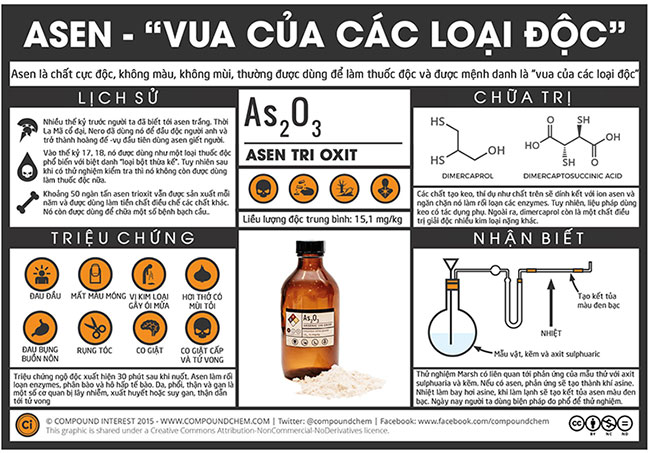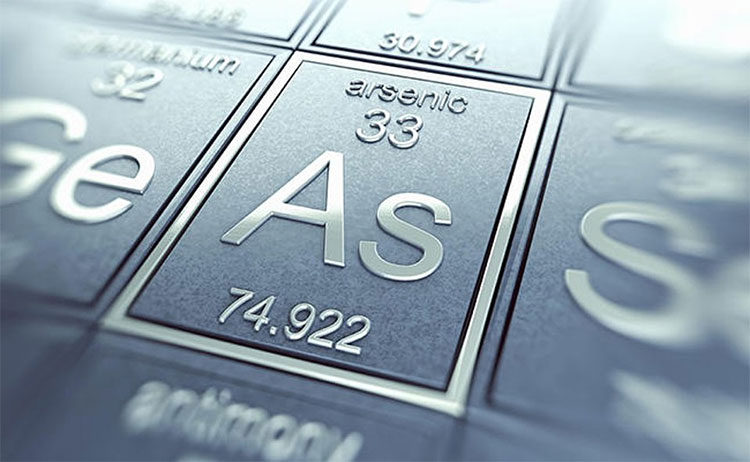What is arsenic, is it harmful or not?
Arsenic (arsenic) is one of the most unique elements in the world, occurring both in the natural environment and created by human activities. Water, air, food, soil, etc. are just a few of the numerous arsenic-containing places.
Since 1991, the US Food and Drug Administration has begun to study arsenic content in human food and finally, they claim that arsenic is not always the same poison as in swordplay movies.
Arsenic has 2 forms: organic and inorganic, they exist everywhere

Turn the periodic table of chemical elements, look at line 4 column 15 will see As, which is arsenic. From a chemical perspective, it is a toxic nonmetallic with many different polymorphs: yellow (nonmetal molecule) and black gray (nonmetallic). Arsenic and its compounds are often used in herbicides, pesticides, . and of course, it is known as a notorious poison in human history. In fact, it is very difficult for you to find arsenic in the single form, but for the most part, it lies with other elements in the form of compounds.
Arsenic compounds are divided into 2 groups:
- Organic arsenic : mostly found in plants and animal flesh tissue. This is a form of arsenic harmless to humans.
- Inorganic arsenic : may be in soil or rock, soluble in water. This is the highly toxic form of arsenic, mainly derived from industrial production.
Both groups, especially inorganic arsenic exist in the environment and its concentration depends on the level of environmental pollution, thereby deciding whether it affects human health or not.
Arsenic is present in nearly every kind of food you eat every day!

It is not until the package of yellow powder is put into the pot to detoxify like in the swordplay that food contains arsenic, in fact, arsenic appears in almost all types of food and drink. However often it only exists in small or very small concentrations. Particularly, some sources of arsenic in high concentrations include:
- Contaminated drinking water : Millions of people around the world are exposed to, using drinking water containing high levels of inorganic arsenic.
- Seafood : Fish, shrimp, shellfish, snails and some other seafood can contain large amounts of organic arsenic. However, a few specific seafoods also contain inorganic arsenic.
- Rice : arsenic can be found in many plants but rice and rice products with arsenic content are thought to be higher. In fact, this is the largest food source that contains inorganic arsenic, which is inherently more toxic. However, that content is still safe for the diet of eating rice every day.
The reason why rice is higher in arsenic than other plants is due to growing conditions. Although arsenic-containing pesticides are now largely banned from production or use, once used, their residues remain in the soil for very long, perhaps 50 years or more. .
Meanwhile, rice is mainly grown in water-rich fields, from which the inorganic arsenic will then follow the soil, allowing water to penetrate into rice grains more easily. Fortunately, arsenic that exists on rice grain is mainly concentrated in the shell and outer layer of the rice grain, through the milling process has been somewhat removed. Then when cooking, we are told to wash the rice before cooking, which will push the arsenic down to the least harmful level. This is probably also the reason why "Plates are less toxic than Cam" ?
Other plants, vegetables, and seeds also contain certain arsenic in them because they are still cultivated on land where natural arsenic is still present. Similarly, arsenic is present in water and seafood contains arsenic, of course, the concentration depends on the level of pollution of the water source. So organics organic arsenic does not? The answer is yes because it is naturally grown on soils containing naturally occurring arsenic, regardless of whether the farming method is customary or organic.
Arsenic poison, but only when you put the whole package into food, you will die! Normally we eat arsenic every day!

Needless to say, pure arsenic is a very toxic chemical. It is likened to the poison of kings and the king of poisons. Why? The reason is that since ancient times people have used arsenic to poison each other. Symptoms of poisoning are quite vague so it is easy to use in poisoning. Of course, its toxicity is known today, so even killing rats is of little use because of its danger.
When the safety threshold is exceeded, arsenic in food, water or air will become toxic to humans. The American Government Association for Industrial Hygiene regulates arsenic concentrations that cannot exceed 10 micrograms per cubic meter of air. The US Environmental Protection Agency stipulates that the amount of arsenic in water cannot exceed 10 parts per billion (PPB). The US Food and Drug Administration regulates that in food, the maximum arsenic concentration is only 0.5 to 2 parts per billion.
However, on a normal level, each of us each intake a certain amount of arsenic, no matter where you are, how clean you eat. The FDA asserts that the daily diet contains very little arsenic and therefore does not cause any acute poisoning effects on the body. If tolerated in large amounts in a long time, it can lead to many effects such as increased risk of cancer, narrowing or blockage of blood vessels, causing high blood pressure, heart disease or type 2 diabetes. Neurological effects, for children or adolescents, if exposed to arsenic for a long time will cause impairment of brain function, thereby affecting the ability to absorb, learn and memory.
Stay away from rat poison! Normally, eating and drinking clean and comfortable food is much more worrisome!
Normal food itself still contains arsenic and this amount of arsenic is not harmful to the body. However, if you still care and want to reduce arsenic in food to a minimum complex, then depending on the type of food that has different ways, mainly in the preparation and cooking of food. The paradox is that brown rice is said to have a higher nutritional content than ordinary rice but due to the absence of vigorous milling, the arsenic residue in it is also higher. And the way to reduce arsenic in both white and brown rice is to thoroughly wash and cook in clean arsenic water. Experiments show that washing rice before cooking will reduce the arsenic by 10 - 28%, while washing with lots of water will reduce arsenic in rice, in return, the nutrient content will follow. more.
It should be noted that even brown rice and conventional processing that we make every day is still safe for health. In other words, the diet with normal foods, although arsenic is still there, is still at a safe level, no need to worry.
- India develops arsenic detection techniques
- Hanoi underground water 'arsenic contamination' to foreign newspapers
- How much arsenic in water is dangerous?
- Finding ferns that can live in arsenic-polluted environments
- Drinking dangerous arsenic water like smoking
- Origin of arsenic poison in groundwater in Vietnam and neighboring countries
- Folic acid can detoxify arsenic in the blood
- Found moss that can filter out arsenic in water
- Filtration of arsenic-contaminated water
- Panic because of water poisoning
- 20 million Chinese people can poison arsenic
- Simple solution to treat arsenic contaminated soil
 'Fine laughs' - Scary and painful torture in ancient times
'Fine laughs' - Scary and painful torture in ancient times The sequence of numbers 142857 of the Egyptian pyramids is known as the strangest number in the world - Why?
The sequence of numbers 142857 of the Egyptian pyramids is known as the strangest number in the world - Why? History of the iron
History of the iron What is alum?
What is alum? The mystery of people using poison as a tonic in 19th century Europe
The mystery of people using poison as a tonic in 19th century Europe  Finding ferns that can live in arsenic-polluted environments
Finding ferns that can live in arsenic-polluted environments  Detecting microorganisms that live on ... 'arsenic' in the Pacific Ocean
Detecting microorganisms that live on ... 'arsenic' in the Pacific Ocean  9 types of rocks - beautiful but deadly minerals present on Earth
9 types of rocks - beautiful but deadly minerals present on Earth  Rice and risk of arsenic exposure
Rice and risk of arsenic exposure  Nuclear 'eyes' revealed Napoleon was not poisoned
Nuclear 'eyes' revealed Napoleon was not poisoned 